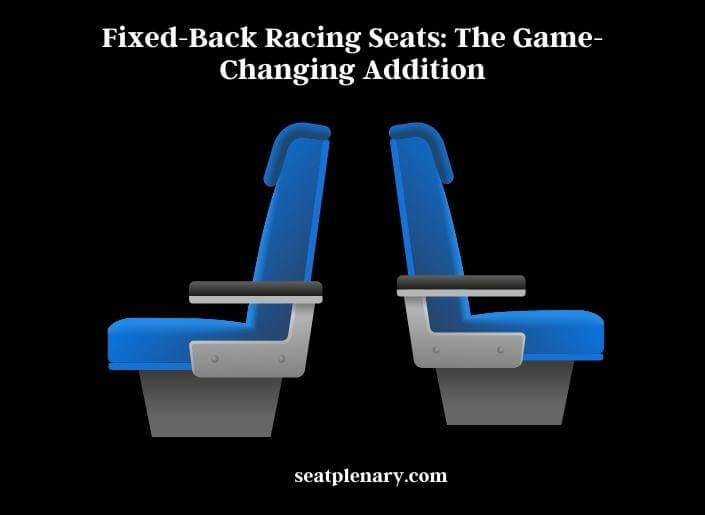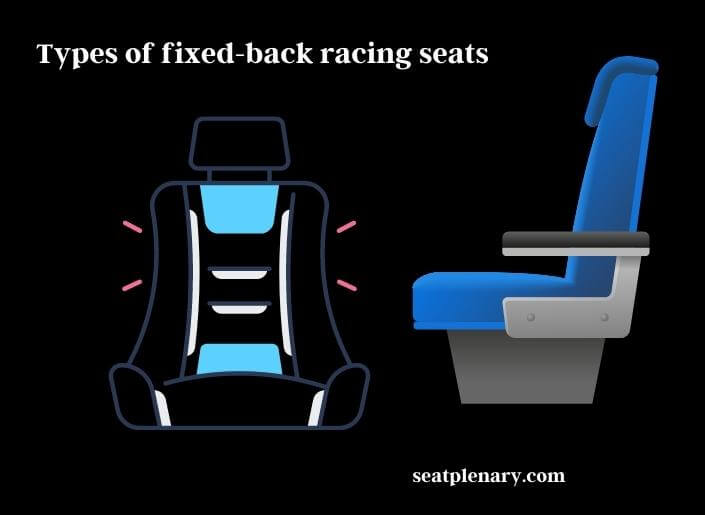When it comes to motorsports, safety is of utmost importance. Drivers face numerous risks on the track, from high-speed collisions to sharp turns and sudden stops. To reduce the risk of injury and ensure their safety, drivers rely on a variety of safety equipment, including helmets, harnesses, and specialized seats.

One of the most important pieces of safety equipment for any racer is a fixed-back racing seat. These seats are designed to offer a high level of support and stability to the driver, ensuring that they stay in place during high-speed maneuvers.
But fixed-back racing seats are not just about safety – they also offer a range of benefits for the driver, including improved comfort, better control, and reduced weight for improved performance.
What Are Fixed-Back Racing Seats?
Fixed-back racing seats are specialized seats designed for use in motorsports. They are built to provide maximum support and stability to the driver, keeping them securely in place during high-speed maneuvers. These seats are typically made from lightweight materials, such as aluminum or composite materials, which helps to reduce the overall weight of the vehicle.
To provide enhanced safety, fixed-back racing seats offer improved comfort for the driver, particularly during long races. They are designed to minimize fatigue and discomfort, allowing drivers to stay focused and alert throughout the race.
Fixed-back racing seats are also designed to improve control and stability while driving. With a fixed-back racing seat, the driver is firmly held in place, enabling them to maintain better control of the vehicle, particularly during high-speed maneuvers and tight turns.
Another advantage of fixed-back racing seats is their ability to reduce weight for improved performance. Because they are typically much lighter than traditional seats, they can help to reduce the overall weight of the vehicle, which can lead to improved handling, acceleration, and fuel consumption.
Types of Fixed-back Racing Seats
There are several types of fixed-back racing seats available on the market today, each with its own unique features and advantages. Here are some of the most common types:

Bucket Seats
Bucket seats are the most traditional type of racing seat. They are designed to hold the driver in a fixed position, preventing them from sliding around during high-speed maneuvers. Bucket seats typically offer good support and are available in a range of sizes to accommodate different body types.
You have to know that low-back bucket seats are a popular option for drivers who spend long hours on the road and need extra support and comfort. These seats are designed to mold to the shape of your body, providing even weight distribution and reducing pressure points.
Composite Seats
Composite seats are made from lightweight materials such as fiberglass or carbon fiber. They are designed to be both lightweight and strong, providing maximum support while minimizing weight. Composite seats are often used in high-performance racing vehicles where weight is a critical factor.
Suspension Seats
Suspension seats are designed to absorb shocks and vibrations, providing a more comfortable ride for the driver. They are typically used in off-road vehicles, where the terrain can be rough and unpredictable. Suspension seats are often adjustable, allowing drivers to fine-tune the level of support and comfort they need.
Wraparound Seats
Wraparound seats are designed to provide maximum support and protection for the driver. They feature high sides that wrap around the driver, holding them in place during high-speed turns and maneuvers. Wraparound seats are often used in endurance racing, where the driver needs to maintain their focus and concentration over long periods.
Fixed-Back Seats with Harnesses
Fixed-back seats with harnesses are designed to work together to provide the ultimate in safety and security. The harnesses keep the driver securely in place, while the fixed-back seat provides maximum support and stability. This type of seat is often used in professional racing circuits where safety is of paramount importance.
When choosing a fixed-back racing seat, it’s important to consider your specific needs and preferences. Factors like body type, driving style, and the type of vehicle you’ll be racing should all be taken into account to ensure you choose the right seat for your needs.
How to Choose the Right Fixed-back Racing Seat?
Choosing the right fixed-back racing seat can be a daunting task, especially with so many different options available.

Body Type
The first thing to consider when choosing a racing seat is your body type. Racing seats are available in a range of sizes, so it’s important to choose one that fits your body correctly. A seat that is too small will be uncomfortable and may not provide the necessary support, while a seat that is too large may not hold you securely in place during high-speed maneuvers.
Material
The material the seat is made from is another important consideration. Many racing seats are made from lightweight materials like aluminum or composite materials to reduce weight. Some seats are also upholstered with materials like suede or leather for added comfort.
Style
The style of racing you’ll be participating in should also influence your choice of racing seat. For example, if you’ll be racing in endurance events, you may want a seat with more padding and support to keep you comfortable over long periods. Conversely, if you’ll be racing in high-speed events, you may want a seat that is more minimalistic to reduce weight and improve performance.
Safety
Safety should always be a top priority when choosing a racing seat. Look for seats that meet or exceed safety standards set by organizations like the FIA or SFI. Consider whether you’ll be using a harness with your seat, as some seats are designed to work with specific harnesses.
Budget
Consider your budget when choosing a racing seat. While it’s important to invest in a quality seat for your safety and performance, it’s also important to stay within your budget. There are many affordable racing seats available that offer a high level of support and protection. It’s important to know that reclining racing seats are designed to offer the driver maximum comfort and support, while also ensuring their safety during high-speed races.
Installation and Maintenance of Fixed-back Racing Seats
Installing a fixed-back racing seat is a straightforward process that requires a few basic tools and some mechanical aptitude. Here are the steps involved:
Remove the existing seat – Begin by removing the existing seat from your vehicle. This may involve disconnecting electrical connections or unbolting the seat from the floor.
Install the seat brackets – Most fixed-back racing seats require specific brackets for mounting. These brackets attach to the seat and the vehicle’s floor using bolts or screws.
Mount the racing seat – Once the brackets are in place, you can mount the racing seat to them. It’s important to follow the manufacturer’s instructions carefully to ensure proper installation.
Connect the seat belts – Connect the seat belts to the racing seat. Make sure they are properly secured and that the harnesses are correctly adjusted.
Maintaining a fixed-back racing seat is also important for safety and longevity. Here are some tips for maintaining your racing seat:
Keep it clean – Regularly clean your racing seat with a soft cloth and mild soap. Avoid using harsh chemicals or abrasive cleaners, as they can damage the upholstery or the seat frame.
Check the bolts – Periodically check the bolts that hold the racing seat in place to ensure they are tight and secure. Loose bolts can cause the seat to shift or move during a race, potentially leading to an accident.
Inspect the upholstery – Check the upholstery for any signs of wear or damage. Tears, cracks, or other damage should be repaired as soon as possible to prevent further deterioration.
Replace worn parts – If any part of the racing seat becomes worn or damaged, replace it immediately. This includes bolts, brackets, and harnesses.
Verdict
Fixed-back racing seats are an essential component of any race car, providing a safe and supportive environment for drivers during high-speed maneuvers. With so many different options available, it’s important to choose the right racing seat for your body type, racing style, and budget. By taking the time to research and select the right racing seat, you can enjoy improved safety, comfort, and performance on the track.
Once you have chosen a fixed-back racing seat, proper installation and maintenance are key to ensuring its longevity and effectiveness. Following the manufacturer’s instructions carefully and regularly inspecting and maintaining your racing seat can help prevent accidents and ensure that you get the most out of your investment.
Whether you’re a professional racer or a weekend enthusiast, investing in a quality fixed-back racing seat is a smart choice for improving your performance and safety on the track. With a little research and careful consideration, you can choose a racing seat that meets your needs and provides the support and protection you need to achieve your racing goals.
